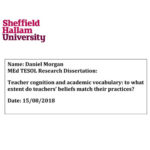How To Teach Writing Across The Curriculum: Ages 6-8
2nded. S. Palmer. New York: Routledge, 2011. Pp. xii + 94
Reviewed by:
Seyede Zahra Hashemi
Department of Foreign Languages, Islamic Azad University, Shiraz, Iran
Amin Borhani
Department of Foreign Languages, Islamic Azad University, Shiraz, Ira
How to Teach Writing Across The Curriculum: Ages 6-8, is a practical resource which equips teachers with the essential skills and materials required to teach non-fiction writing skills. It provides teachers with innovative suggestions for teaching writing skills to children. The author believes that learning to write is a “critical element in the development of children’s thinking skills” (Palmer, 2011, p. x) and that literacy “change[s] the architecture of the brain” (ibid, p. xi). The book provides the reader with:
- “techniques for using speaking and listening, drama and games to prepare for writing;
- suggestions for the use of cross-curricular learning as a basis for writing;
- planning frameworks and ‘skeletons’ to promote thinking skills;
- information on key language features of non-fiction texts;
- examples of non-fiction writing;
- guidance on the process of creating writing from ‘skeleton notes”(ibid, p.i).
In the introduction, the author discusses the differences between speaking and writing, the importance of writing, and the starting point at which writing should be learnt. The sub-skills that children require before they start writing are described and speech is referred to as a type of spontaneous, interactive activity which occurs “within a shared context” (ibid).
The book has four chapters. The first one, entitled “The two horse’s model for cross-curricular writing”, argues that before children learn how to talk you can’t teach them how to write. As the author points out, you can’t put the cart before the horse (p. 1). Two sorts of talk are mentioned as the foundations of writing: talk for learning and talk for writing. This chapter discusses four major non-fiction text types; recounts, reports, instructions, and explanations. Also, in this chapter, the author provides the reader with skeleton planning frameworks and the advantages of using such frameworks to develop children’s thinking skills. The second section of chapter one pays special attention to certain language features that characterize each text type. To familiarize children with the types of words, phrases, and sentence structures associated with different types, the author offers two practical suggestions: read examples of the text type to children using the RA-RA-RA technique (Read Aloud, Read Along, Read Alone), and use the language of writing by creating speaking frames for the sorts of sentences the children are expected to produce in their writing.
The second chapter, “Case studies”, includes four sections. In the first section, “recount writing” the author recommends using pictures or simple words on timelines to improve children’s recognition of time. In addition to developing memory skills, such visual models can aid children’s concentration ability so that they will stop worrying about what to write. In the second section of chapter two, “report text” the author introduces a spider-gram skeleton to aid in writing reports. The steps involved in making a spider-gram are summarized in the acronym BOS (Brainstorm, Organize, and Spider-gram). The reported case studies in this section show how interactive whiteboard, hoops, and BOSsing technique can be used to make the spider-gram report skeleton. Such visual aids can be very useful in producing ideas in writing reports. The third section of part two, “instruction writing”, deals with making flow charts to assist children in sorting out steps involved in instruction writing. In the fourth section of part two, “explanation writing”, flow charts are introduced as a useful way of writing explanations that require an understanding of cause and effect. This section provides case studies and ideas from teachers who have used explanation flowcharts, timelines, and spider-grams with their classes.
In chapter 3 of the book, “Teaching materials”, the author elaborates on the four types of writing and explains the purpose, text structure, and language features of each type along with some valuable key teaching points. Recount texts which are used to “retell events in time order,” are the most common type of non-fiction writing; report texts, used to “describe the characteristics of something,” are usually non-chronological; instruction texts are used to “tell someone how to do or make something”; and explanation texts “explain how or why something happens”. The author includes an example for each type of writing and shows how shared reading followed by shared writing can improve children’s writing skills. Collaborative work is emphasized throughout the book.
Chapter 4, “Appendices”, contains three sections. The author supplies the readers with some nuts and bolts of teaching writing skills in the first appendix, elaborates on shared, guided, and independent writing in the second one, and provides some case study materials in the third. Practical suggestions in this chapter are designed to foster collaboration amongst children, as well as boost their confidence and independence in doing written work.
The main focus of the book is the significant role that speaking and listening play as a prerequisite to any writing activity. Providing opportunities for children to learn to talk before teaching them how to write and using skeleton planning frameworks as well as a timeline skeleton are crucial to the development of ideas and concepts necessary for good writing. The first chapter leaves the reader with some ambiguities which are resolved in the chapters that follow. Besides contributing to the understanding of recount, report, instruction, and explanation texts as teaching materials, the book boasts enlightening case studies, and effectively addresses teachers interested in using innovative ways to teach writing. The book’s major strength lies in its comprehensive coverage providing teachers with clear guidelines along with detailed case studies. Overall, for its practical ideas, its readability, and its many examples, this book is recommended to teachers in search of innovative methods of writing.








